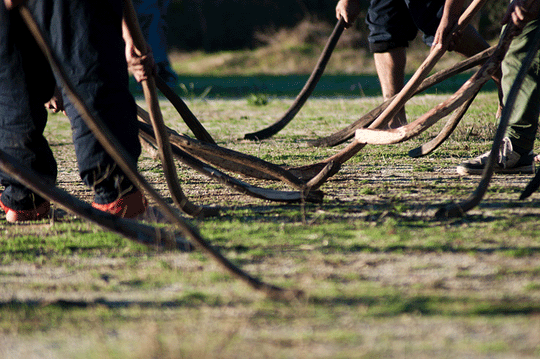



By Tom Hyne
Published On : Tue, Nov 18th, 2014
The ancient Mapuche sport of palín is making a comeback in Santiago, ‘reinforces friendships’ while typifying struggles of Chile’s indigenous communities.

While it is no longer used to settle tribal disputes, palín still maintains a strong social element and has become synonymous with the Mapuche struggle. Photo by Hugo Solar / Flickr.
Palín is not for the faint-hearted — the age-old Mapuche sport was once used to settle tribal disputes and involves pumped-up men running around a dirt field swinging huge wooden sticks. Outlawed in the 17th century by the Catholic church, the sport has made a comeback in recent years spearheaded by the formation of an eight team league in Santiago.
Christened “chueca” by the Spanish conquerors, the preservation of palín has become synonymous with the struggles of Chile’s indigenous communities. As the country comes to terms with its conflict-ridden past, the government named palín a national sport in June 2004 — the move came after pressure from various Mapuche movements demanding recognition for their role in the country’s history.
“The sport, and its social function, have not changed substantially since its conception many years ago,” Jorge Calbucura, a specialist in Mapuche sports and associate professor of sociology at Mid Sweden University, told The Santiago Times. “Its numerous purposes come from its role as a form of escape, a social cohesive and a mediator of conflict. The past social function of palín has to be understood in a certain social and historical context. Above all, palín is more than just a sport — it is an exercise in cultural resistance and identity.”
Santiago’s palín teams convene every Sunday from March through December in Cerro Navia, La Pintana, Quilicura and Puente Alto. Despite the fierce history of the sport, those who play in the league uphold the social spirit of the game.
“It’s not competitive as such, but more to reinforce friendships between communities,” Pablo Painemilla, who takes part in the weekly tournaments, said.
Games consist of two teams of between five and 15 players named “peloteros” — each player has a special role to play and is paired off against their opposite number, called “kons.” The field of play, coined a “paliwe,” is traditionally 655 feet long and 40 feet wide and the aim of the game is to hit the wooden ball into the opposing goal. Both teams share a meal post-game to “strengthen relationships between communities.”
Calbucura also spoke of why the ancient sport is still significant for the country’s indigenous population.
“For quite some time now, especially since the celebration of ‘500 Years of Resistance,’ there has been an increased awareness throughout the Americas of the indigenous people’s plight,” he explained. “This has given birth to a process of cultural revitalization, inspired by organizations which represent indigenous interests — especially in urban areas. Palín is a great example of this.”
While palín is alive and kicking in Mapuche society, Calbucura offered his thoughts on whether the sport could become popular in Chile.
“Before it becomes more popular I think there needs to be a greater awareness throughout indigenous communities in the Americas. However, if you compare palín to other minority sports in Chile, such as a number of watersports or polo, then it is not too far behind in terms of the number of people who play.”
Source:The Santiago Times